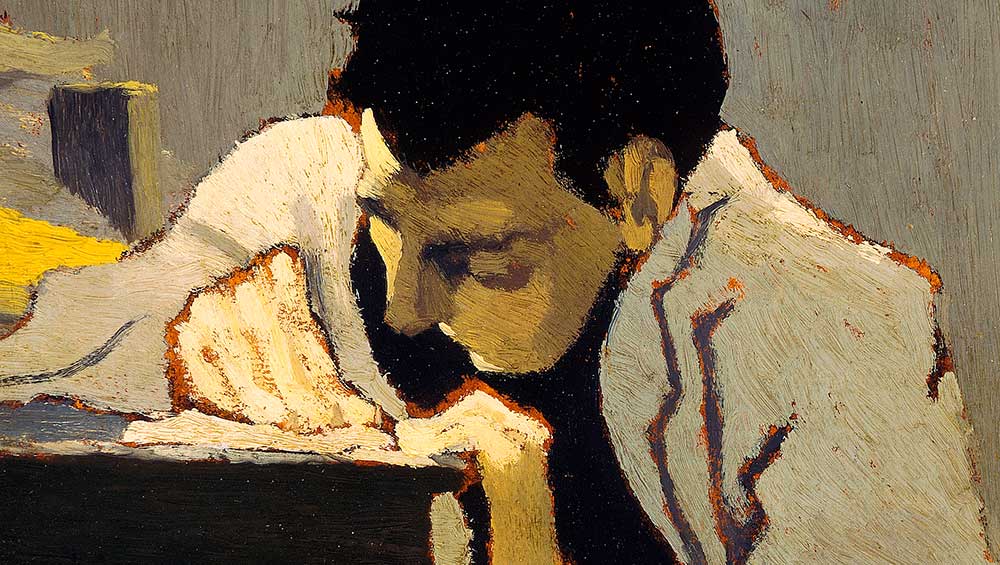
Edouard Vuillard, Lugné-Poë, 1891 (detail). Oil on canvas, 22.2 x 26.7 cm. © Memorial Art Gallery of the University of Rochester.
National Gallery, London
25 March – 13 August 2023
by DAVID TRIGG
We can only surmise what the suited men in Maurice Denis’s painting Homage to Cézanne (1900) are saying as they gather around the eponymous artist’s Still Life with Fruit Dish (1879-80), but the atmosphere is one of excited reverence. It was the beginning of a new era and these men belonged to a fresh generation of Parisian artists who were ushering in what we loosely call “modern art”. Christening themselves the Nabis (Hebrew for “prophets”), this group of self-styled prophets of the modern age – including Paul Sérusier, Pierre Bonnard, Édouard Vuillard and Denis himself – revered Paul Cézanne’s vocabulary of geometric form and Paul Gauguin’s radical, non-naturalist style. Alongside artists from across Europe, they experimented with simplified forms, flattened areas of colour and limited palettes to create works that shocked and amazed.
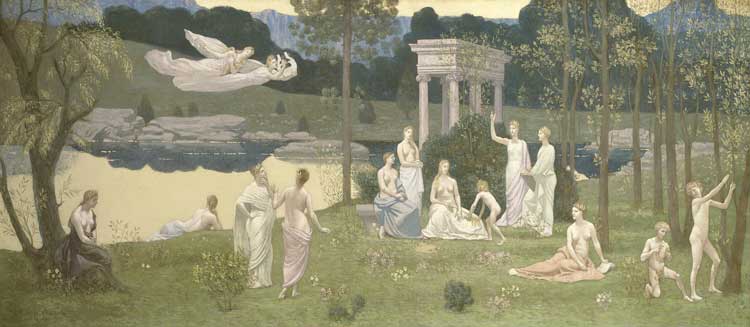
Pierre-Cécile Puvis de Chavannes, The Sacred Grove (Le Bois sacré), 1884/9. Oil on canvas, 93 x 231 cm. © The Art Institute of Chicago.
Conceived by the art historian MaryAnne Stevens, After Impressionism: Inventing Modern Art takes us on an exhilarating journey, from the gentle innovations of Pierre Puvis de Chavannes to the extreme abstraction of Piet Mondrian. Focusing on the brief but intense period between 1886 and 1914 – from the final impressionist exhibition to the eve of the first world war – the exhibition charts the myriad ways in which artists questioned the nature of the relationship between art and the external world. Paris naturally provides the backbone, though the spotlight is also shone on other “centres of creative ferment” across Europe – cities such as Barcelona, Brussels, Berlin and Vienna, where important avant-garde exhibiting groups sprang up, creating networks of influence and exchange.
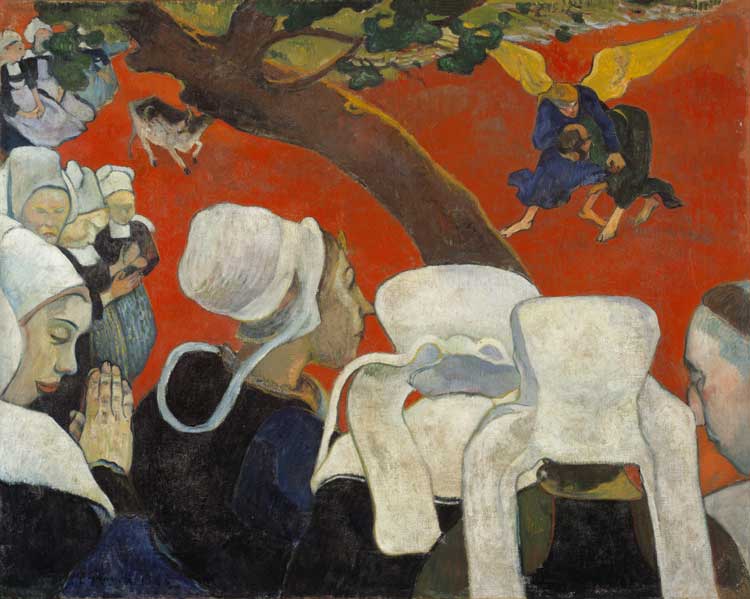
Paul Gauguin, Vision of the Sermon (Jacob Wrestling with the Angel), 1888. Oil on canvas, 72.20 x 91.00 cm. © National Galleries of Scotland, Edinburgh.
The generous selection of works by Cézanne, Vincent Van Gogh and Gauguin that fill the second room is a delight, setting the scene for much of what is to come. Working across landscape, still life and portraiture, Cézanne challenged the notion of naturalism, flattening the picture plane and reducing the observable world to simple geometric shapes. Van Gogh suggests that the physical properties of paint are as important as what is being represented in his late landscapes with their heavily loaded brushwork, while Gauguin shows how paint can takes us beyond what is seen; his Vision of the Sermon (Jacob wrestling with the Angel) (1888) depicts a praying group of bonneted peasants in a blood-red field who conjure the biblical narrative in their mind’s eyes – an intertwining of the terrestrial and the spiritual.
The Nabis drew great inspiration from Gauguin’s rejection of realism and use of artificial colour. Sérusier, under direct guidance from Gauguin, painted The Talisman (1888), an extraordinary semi-abstract landscape in which the natural world becomes a vivid decorative surface. That this small work was made so soon after the final impressionist exhibition is astonishing. In a room dedicated to artists working in Barcelona and Brussels, we meet radical Spaniards such as Ramón Casas and Picasso, who by 1901 was already experimenting with different styles. In Brussels, the group Les XX explored the possibilities of pointillism, inspired by the neo-impressionist innovations of Georges Seurat and Paul Signac. But the fly in the art historical ointment is James Ensor’s Astonishment of the Mask Wouse (1889), a proto-surrealist painting depicting a group of grotesquely masked figures that skewers the notion of modern art evolving in a linear fashion.
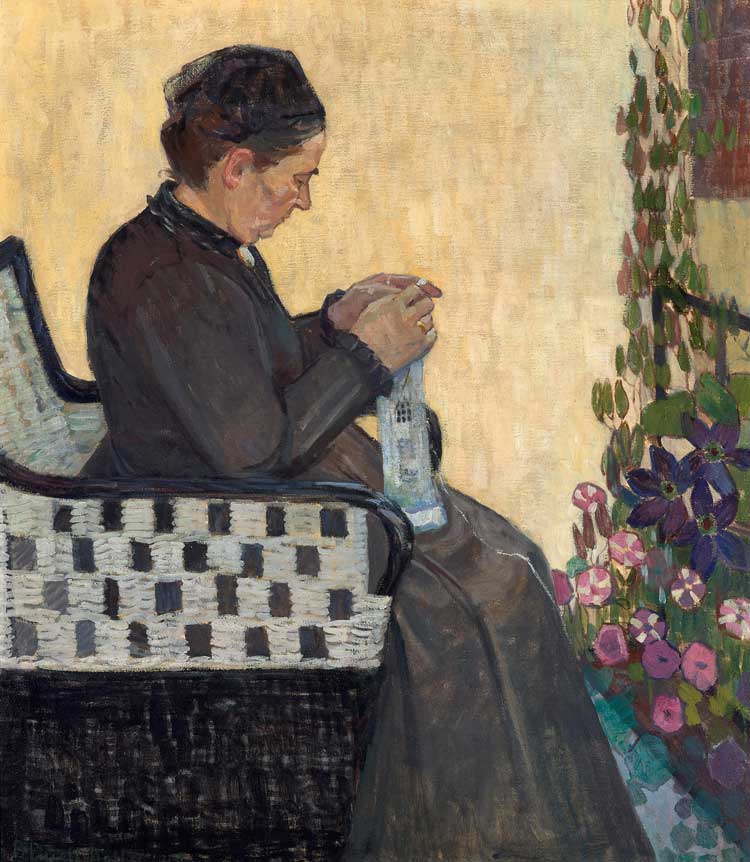
Broncia Koller-Pinell, Die Mutter der Kunstlerin, 1907. Oil on canvas, 91 × 77.5 cm. © Artothek des Bundes, on permanent loan at the Belvedere, Vienna.
The Viennese section is surprisingly slim, with Egon Schiele and Oskar Kokoschka curiously absent. The influence of James Abbott McNeill Whistler is felt in the silvery tonalities of Gustav Klimt’s celebrated 1904 Portrait of Hermine Gallia, not to mention Broncia Koller-Pinell’s canvas The Artist’s Mother (1907). Klimt’s palette exploded with colour after he visited Paris for the first time in 1907, evinced by his Portrait of Adele Bloch-Bauer II (1912), in which the serene socialite stands against a highly patterned background of embroidered Chinese fabrics and carpet.
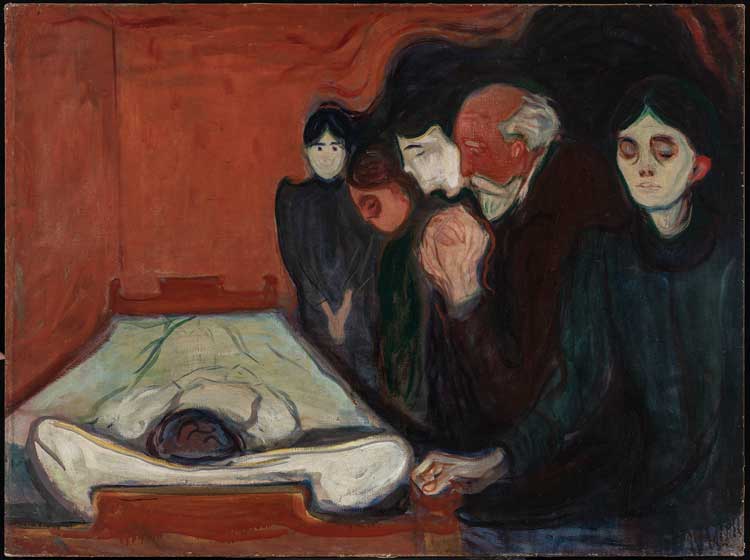
Edvard Munch. The Death Bed (Ved dødssengen), 1895. Oil on canvas, 90 x 120.5 cm. KODE Bergen Art Museum. © Dag Fosse/KODE.
In Berlin, we meet Edvard Munch, who briefly made the city his home in the 1890s. Though his first version of The Scream (1893) was conceived here, we are treated instead to The Death Bed (1895), a haunting vision of the grief he and his family experienced following his sister’s death. Munch’s works are juxtaposed with expressionist sculptures by Ernst Barlach and Käthe Kollwitz, and paintings by Max Slevogt and Lovis Corinth, who pushed at the boundaries of middle-class respectability. Corinth’s 1911 portrait of the voluptuous Parisian sex worker Nana (the title character from Émile Zola’s 1880 novel) challenged traditional approaches to the nude in art; to modern eyes, his sensuous paint handling bears more than a passing resemblance to that of Lucian Freud.
The dearth of female artists here is surprising. The period covered by the show was notable for the high number of women entering art schools and for their participation in exhibitions in Paris and other European cities, yet their contributions to the development of modern art are barely considered. Of the 97 works in the show, just five are made by women: paintings by Koller-Pinell, Paula Modersohn-Becker and Sonia Delaunay, and sculptures by Kollwitz and Camille Claudel. This despite Stevens noting in the catalogue: “Women artists who engaged with the modernist agenda were by no means invisible during the period.” Could room not have been made for Marie Laurencin, Suzanne Valadon, Gabriele Münter and Marianne von Werefkin? And what of artists such as Jacoba Van Heemskerck and Natalia Goncharova?
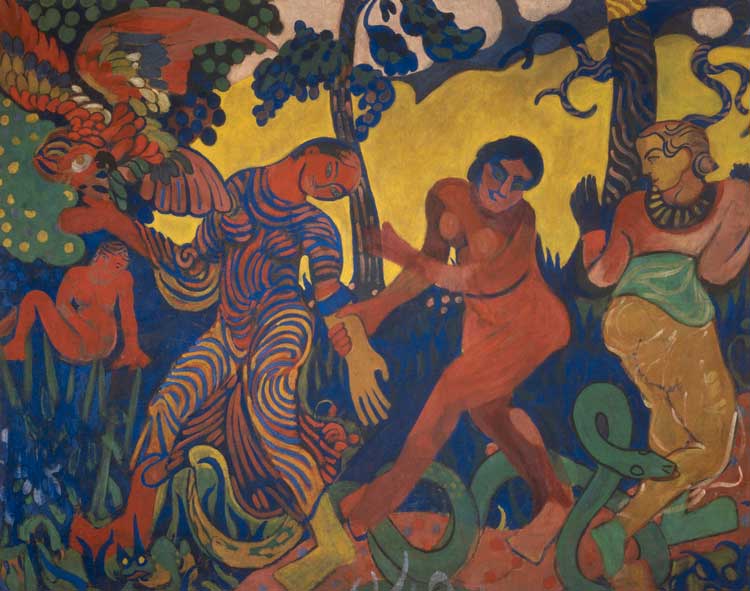
André Derain, La Danse, 1906. Oil on canvas, 180 × 228 × 3 cm. Private Collection. © ADAGP, Paris and DACS, London 2023 / photo courtesy of the owner.
Where the show really excels is in the large number of works from private collections, many of which have not been seen in public for a very long time, if at all. This is true of four Van Gogh paintings, including the mesmerising Houses in Saintes-Maries-de-la-Mer (1888), depicting low-roofed cottages in a Mediterranean fishing port with a vibrant, exaggerated palette, and the richly textured Sunset at Montmajour (1888), a work previously dismissed as a fake. The sole Delaunay painting, Young Finnish Woman (1907), in which a girl’s face becomes a garish patchwork of flat, unmodulated colours, is also in private hands, as is André Derain’s wonderful canvas The Dance (1906), where brightly coloured bodies cavort through a jungle with a twisting snake.
The speed picks up in the show’s final rooms as art hurtles towards pure abstraction. Here, we find Henri Matisse’s fauve masterpiece Interior with a Young Girl (Girl Reading) (1905-06), showing the artist’s daughter quietly reading in a room alive with exuberant colour and pattern. Hanging opposite is Picasso’s Woman with Pears (1909), in which the head of Fernande Olivier is reduced to a series of sharp-edged facets in a style presaging cubism. Nearby, three paintings of a tree by Mondrian show the painter’s journey to geometric abstraction between 1906 and 1912, moving from an essentially naturalistic representation of the subject to its dissolution into a series of lines and curves. It is a neat curatorial move, but as the rest of the exhibition so ably demonstrates, the evolution of modern art was rarely this tidy.